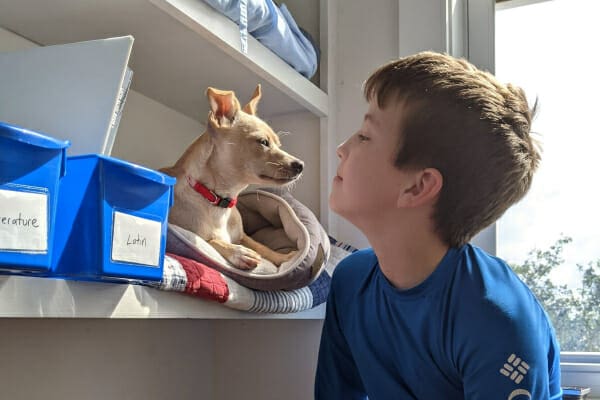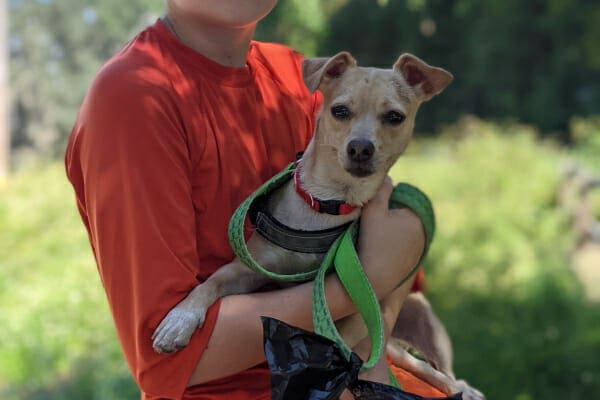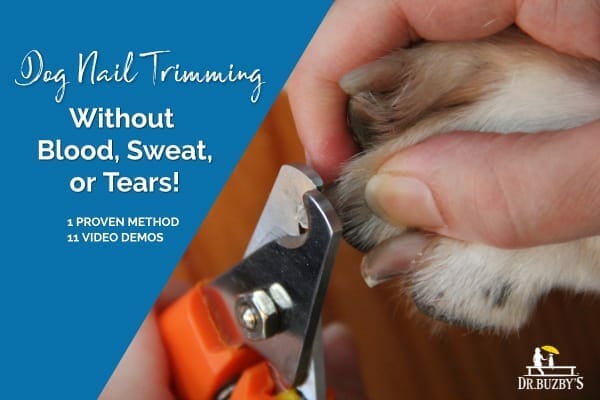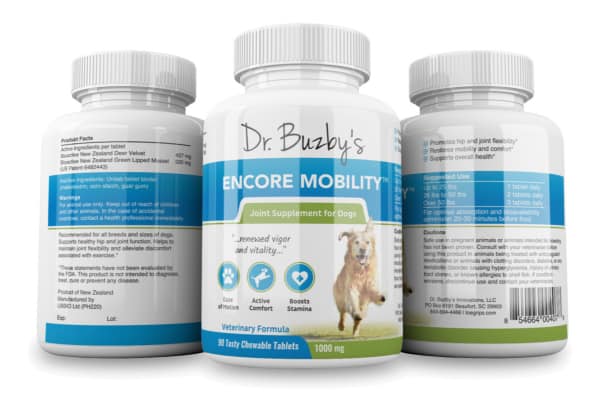Chihuahua care has its own set of joys and challenges. Keeping these adorable pint-sized pups healthy requires dedication and attention to some specific details. Integrative veterinarian Dr. Julie Buzby recently welcomed a Chihuahua named Beanie to her heart and home. Based on that experience, and her newfound & unexpected passion for Chihuahuas, she compiled these five Chihuahua care tips.

On July 4th, I adopted my first Chihuahua, and like any good dog mom, I did my homework.
As I got sucked to the Google search vortex, my first surprise was that 2500 people per month type into the search window, “Are Chihuahuas rodents?” Thankfully, my veterinary degree prepared me to answer that one.
But all the years of caring for Chihuahuas as patients had not prepared me for what it was like to live with one.
Suffice it to say, I’d never seen this side of a Chihuahua in the veterinary setting. I was expecting 300 pounds of Rambo in a small dog body. Instead, we got a feisty version of Mr. Rogers, who immediately stepped into his role as the perfect best friend for my son. We also got a four-pawed comedy act, a loyal protector, and the most photogenic family member—all in the form of a fawn Chihuahua named Beanie.
I started the story by saying “my first Chihuahua” because my husband now tells me on a daily basis that we’re destined to live out our empty-nest years with a posse of Chihuahuas. We’ve all fallen head-over-heels in love.
A fairy tail ending
The story began with my 12-year-old son, David, struggling through the pandemic, desperately in need of a faithful friend. He’d been asking for years for his very own dog, but I wasn’t convinced he was up to the responsibility. But David proved me wrong. This past summer he meticulously cared for MacGregor, our friends’ five pound senior Chihuahua, whom we “dog sat” for two weeks.
He met MacGregor’s every need without ever being asked or reminded. And I was taken aback by how much more David smiled with that little dog in our home.
The doctor in me was quick to assess the situation and make a diagnosis—our household had a Chihuahua deficiency! After we returned MacGregor to his family, I began a stealthy search for David’s Chihuahua.

On Independence Day, which I’m sure is appropriately symbolic, all ten pounds of Beanie came to live with us. He’d been found wandering the streets of Savannah with a scruffy mutt, and that dog had already been adopted. Like all “urchin” dogs that I’ve met, Bean seemed to exude endless love and gratitude for his new arrangement.
Confessions of a Chihuahua convert…
Don’t hold this against me, but I’ve always been a “big dog person.” I’ve adopted four other rescues over the years, and they were all about the size of an XL suitcase. It never even crossed my mind to consider adopting a “lap dog,” let alone a Chihuahua. With half of America wondering if these tiny dogs are rodents, you can see why I’d written off the idea.
But I’m writing this cathartic confession to acknowledge the error of my ways. I’m also writing because life with Beanie has made me a better veterinarian. I’ve made some observations that two decades of practice hadn’t taught me. After all, being a Chihuahua’s mom (although David says I’m Bean’s grandmom) is quite different from being a Chihuahua’s vet.
So please allow me to share five tips about loving, nurturing, and caring for a Chihuahua that I’ve gleaned living with Beanie.
5 Chihuahua care and wellness tips
1. Be intentional about how you pick up a Chihuahua
Twenty three years ago I earned my certification from the American Veterinary Chiropractic Association as a dog chiropractor. This means that I see a lot of senior dogs with mobility issues.
It’s not uncommon for parents of small dog breeds to mention, usually as an afterthought, that their dog has become resentful about being picked up. They write it off to aging, but I have a new perspective after living with Beanie.
We pick up this dog A LOT. Always the entertainer and lover, he will come over and ask for the attention. Sometimes he asks by stretching upward on my leg like a cat on a scratching post, sometimes by seeking eye contact and sending me telepathic messages (I’m convinced), and sometimes by using what my veterinary colleague warned me about when she learned of my new addition—the fake tremble.

Her advice: “Look out for the classic Chihuahua manipulation move….’the fake tremble’….. it makes you ask what’s wrong and promptly pick them up!”
(Why do Chihuahuas shake is one of those mysteries of the universe. My article Is Your Dear Old Dog Shaking? may help with the answer. However, I do sometimes suspect I’m dealing with a dog whose IQ is higher than mine, and he’s playing me like a fiddle.)
How should you do this not-so-heavy lifting?
Naturally, we never pick up our hound or Boxer mix and stroll around our house. But it seems we are constantly toting Beanie around like pampered royalty.
In our home of all right-handed humans, this means Bean is usually picked up by a right hand scooping under his right side and swooping him up to our chest. It’s rare (if ever) that we pick him up with a left hand. So think about what this constant unidirectional force into the sternum and rib cage could mean over the course of his doggy lifetime. There is no lifestyle counterbalance to this torque. Can you see that over time this could set up for soreness or even a repetitive strain injury?
Intuitively, David always picks up Bean with two hands, infinite tenderness, and full body support. I’ve never had to correct his technique. But for the rest of us, allow me to provide a friendly PSA reminder:
Please be intentional about how you pick up your dog. Provide balanced, full-body support. I hypothesize that training yourself to be ambidextrous in your Chihuahua “lifts” could even be really helpful.
2. Beware of the “chubby Chihuahua” weight creep
Beanie came to us freshly neutered. So fresh, in fact, that he had a red incision between his hind legs and a fair amount of swelling. As an evangelist for laser therapy for dogs to speed healing, my initial bonding experience with Bean was lasering his crotch daily.
Why do I mention his neuter? Because I feel inherently sorry for chubby Chihuahuas that look like pigs-in-a-blanket. It’s a common issue for many dogs—large or small—and I don’t want that for Bean. Spaying and neutering will decrease a dog’s metabolism. It’s a scientific fact. I’m absolutely still pro-spay and neuter, but think it is important dog parents realize these dogs then need less calories to maintain their condition.

Your veterinarian can help you calculate specific feeding guidelines and even plot your dog’s progress on a graph in his or her medical record. For example, Beanie only needs to eat about 350 kcals (what we refer to as calories) per day. If I give him a heaping measuring cup at breakfast and dinner and provide calorie-dense treats a few times throughout the day, I’m going to have a 15-pound Chihuahua in a matter of months.
On top of that, when you only weigh 10 pounds, adding a pound of extra body weight is significant—it represents a 10% gain in total mass. It’s a totally different ballgame than an 80 pound Labrador gaining one pound.
Because small changes in weight gain “show” more quickly on my little Chihuahua’s waistline, I’ve had to be careful about monitoring his calorie intake and exercise (calorie burn). I need this perfect little dog to live forever, and keeping him healthy and fit is on me!
Pro tips for weight management
Learn the three quick and easy steps to find your dog’s body condition score so that you can monitor body condition changes and trends at home. And check out these articles if your pup needs to lose some pounds:
- How to Help a Dog Lose Weight (Without Losing Your Mind)
- Is My Dog Overweight? Your 7 Most Weighty Questions Answered
3. Quell the 10-pound tap dance
If you know me at all, you know I love trimming dogs’ nails. I used to joke with my clients, “Michelle Obama has childhood obesity, and I have dog toenails.” It’s my platform…my soapbox…my passion.
So imagine my horror when I hear a staccato “tick, tick, tick” as Bean’s nails click along our hardwood floors. “I just trimmed his nails!” I think. “How is this possible?”
Do small dog’s nails grow faster?
Do Chihuahua’s nails grow faster?
I don’t have the answers, but I do know that I have to keep on top of Bean’s nails more often than my bigger dogs.

Why do I care so much (and want you to also)?
Let’s begin by stating the obvious—no one wants a Chihuahua with talons—that would surely be rodent-esque! But it’s so much more than that. Long nails impact your dog’s posture and gait. Nail maintenance is not just a cosmetic issue, it’s inherent to your dog using his or her body correctly and staying healthy for a lifetime.
So I trim Beanie’s nails on a weekly basis. Because he’s “blond”, his nails are light colored and it’s very easy for me to avoid hitting the quick—where the blood vessel and nerve run together. But no matter what color your dog’s nails are, I can show you how to trim your dog’s nails without blood, sweat, or tears. You can learn to recognize “landmarks” or “guide points” when trimming the nails to ensure that your dog (and you!) never have a bad experience.
Check out my 11-module master course on canine nail trimming if you’d like to learn more, but no matter what, make it a priority to keep up with your dog’s nails.

4. Start a joint supplement early
Rodent, no. Cat, yes!
I’m convinced Beanie thinks he’s part feline. He’s constantly jumping, with the agility of a trapeze artist, to higher vantage points for a more commanding life perspective. At one point David nicknamed him “Shelf Dog” because Bean routinely sought to curl up on a shelf above David’s head while he did his homework.
I tried repeatedly to curtail this daring doggy behavior because the “dismount” scares me, but I have come to terms with accepting this as a “Beanie Norm” and put a dog bed on his shelf of choice.
But Beanie’s combination of tenacity, bravery, and athleticism creates a lot of wear and tear on his little body. Not to mention that these small breed dogs often have issues with luxating patellas in dogs (a biomechanical issue that leads to degeneration in the knee(s) and arthritis.
I typically start joint supplements for my own dogs (and my healthy patients) around middle adulthood (five-ish to seven-ish, on average). But with Beanie, counterintuitive as it might seem because he’s the “baby” of our pack at 12 months old, I’ve already started him on a joint supplement.
I want his joints, tendons, and ligaments to have all the “building blocks” they need to recover from his antics and I feel good about providing his body the natural anti-inflammatory effects of a joint supplement too.

The best joint supplement for dogs
Of the thousands of joint supplements for dogs out there, which one did I pick? It was an easy decision! Beanie (and all my dogs) take Dr. Buzby’s Encore Mobility™ hip and joint supplement every day. He LOVES it and we give it just like a treat.
Encore Mobility contains green lipped mussel for dogs, which helps keep his joints healthy and naturally pain free.
But the “magic” in Encore Mobility comes from the second active ingredient—New Zealand Deer Velvet. I’ve researched and written extensively about this ingredient, which has been used in traditional Chinese medical formulations for over 2000 years. I invite you to come “nerd out” with me and read the article I recently wrote for Innovative Veterinary Care (a veterinary journal) on deer velvet antler applications in the veterinary setting.
The bottom line is that deer velvet works in a very unique way to help with joint and connective tissue health and healing. And since mobility is a dog’s greatest asset, I want to be proactive now about preserving and protecting Bean’s joints (and thus his future mobility and activity levels).
Save 10% on Encore Mobility™ Joint Supplement for Dogs

Give your dog more good days.
Use promo code HAPPY to save 10% on Encore Mobility.
5. Brush your dog’s teeth daily, and be thankful I’m not asking you to floss too. 😉
Finally, don’t tell Beanie, but I’m going to disclose one of his flaws. Bean, like all the members of the Chihuahua—and toy/small breed—brotherhood, is quite prone to dental disease in dogs (i.e. periodontal disease).
Odds are, by the age of two or three, Bean will have some form of periodontal disease. This is sad to me because right now, in the prime of his youth, his teeth and gums are gorgeous.

I plan to beat the odds and so should you! What’s the #1 most important thing you can do at home to keep your dog’s mouth healthy?
Brush your dog’s teeth every day!
As soon as we’d earned Beanie’s trust, we began to build this dental care habit into our daily routine. We began by just putting doggy toothpaste on a toothbrush and letting him lick it off. Note, any toothbrush is fine (human, baby, doggy, etc.) but the toothpaste does need to be dog-specific. You cannot use human toothpaste for dogs.
We kept the experience yummy for him and gradually worked up to actual “brush strokes,” keeping the sessions very short and sweet. The key at these early stages is providing your dog a positive experience and not worrying about the quality of your brush work.
Eventually, the dog may come to enjoy the regular brushing routine so much that he or she will “remind” you when it’s time to brush and sit patiently through the process.
We’re not yet there with Bean, but we’re all still having fun, which is what matters.
Help your dog keep his or her teeth
I’ve had clients ask me, “How many teeth do Chihuahuas have?” And it’s a funny question because they start out with 42—the same number all adult dogs have, regardless of size.
But if we took an average from Chihuahuas of all ages, I’m guessing Chihuahuas have significantly less teeth than other breeds. That’s because Chihuahuas are prone to periodontal disease. These dogs are losing teeth (either they’ve fallen out or been extracted) as a result of this health issue.
I do not want to feel compelled to add doggy dentures as our next product line. So please help me out here and learn to brush your dog’s teeth.

Beanie the Chihuahua angel
Sometimes I wonder if Bean is an angel in disguise. And then he lunges at the UPS guy or jumps up on our kitchen table, and I realize he’s not actually a cherub. But I still think he was sent to our family from the heavenly realm.
It’s amazing how a dog can fill a hole in your heart that you didn’t even know you had.
What tips would you share about caring for Chihuahuas?
Please comment below.


Thank you for your notes. I also have had large dogs (Anatolian Shepherd Dogs), and I found your site Googling for our new little. Dazey. My question is about her eyes: how to clean the moistness and gunk under her eyes. Not sure if a soft washcloth and water will do, or does she need a specific cleaner?
Hi Susan,
Congrats on the addition of Dazey to your family! A warm washcloth is fine for daily hygiene and care. If the gunk is thick or green this could be a sign of conjunctivitis or an eye infection. Also, many small dogs battle tear staining (brown) under their eyes. If you are seeing any of these signs, I highly recommend you contact your vet. They may need to rule out common issues and can offer guidance on how to properly treat these conditions. Wishing you and your sweet girl many happy years ahead.
My chi is 14 years and has always been a jumper and a barker,but nothing now. I did get a joint medcine for him. I have been giving for 3 days . I know that is going to take a couple of months. Just need to no I am doing the right thing.
Hi Cathy,
I understand your concern for your little guy and think it is great you are reaching out for advice. Joint supplements are always a great idea for arthritis pain and most dogs do very well with them. I do encourage you to discuss this with your vet. It would be best to get a definitive diagnosis of arthritis as the cause for this recent behavior change and rule out the possibility of other more serious issues that could be contributing. Wishing you both the best. Give your sweet boy a hug for me!
Hello, I just adopted my first Chi she is 3 months old and weighs 6lb 9 ounce. Her name is Lucy, she is a lovable, funny and quite active. I’m concerned because she she vomits every night
She doesn’t have diarrhea. Her stool seem very good. The vomit usually consist of a white foam or a clear yellow substance.. my vet has told me to put one or quarter Pepcid it every day that really doesn’t seem to be helping. I started it off giving her dry food now I switched to wet food to see if that makes a difference and it doesn’t. I’m very confused and worried. I just don’t know what to do for her.
Hi Barbara,
I am sorry your little pup is having these vomiting issues. I understand why you are concerned and wish I could give you some good answers. Unfortunately, without examining her myself, it is hard to make specific conclusions and recommendations. It is possible that some of her problem is due to the recent food changes. It can take some time for their GI tract to adjust to a new food and vomiting would be one of the main symptoms you would see. It might be a good idea to talk to your vet about using a probiotic. If that doesn’t help, it may be time to do a more thorough investigation and pursue some testing. Hoping all is well and your girl is living her best life. Feel free to leave an update if you have a chance.
When we decided to adopt a Chihuahua, we ended up getting two (brothers) boys! Both fawn, they are 5 years old now. Pip is built much larger than Ghost (we call him alpha Chihuahua) at nearly 15lbs while Ghost is only 6.5. He makes up for it with attitude. These guys are so awesome! Our first lap dogs, and now we want to keep Chihuahuas for the rest of our lives. They are so special and life enriching. We are convinced Pip squeak is a healer. He can always make you feel better and he wont leave your side until the task is complete. Ghost cries a lot and keeping his eyes clean is a several times a week job. They are the cleanest dogs I have ever had. They never get fleas, or stink, but they still get baths quite often. There is so much more I could say but its late. If you can dedicate yourself to a dog then a Chihuahua could be a great choice because they will return your love a thousand fold. Chihuahuas need attention from their master constantly and plenty of walks.
Hi Matt,
Your two chihuahuas sound wonderful! They really are the best little dogs. Thanks so much for sharing a bit about Pip and Ghost. It is always fun to hear from other other people who have been bitten by the Chihuahua bug!
Just adopted a 2 yo female rescue Chi about a month ago. She has a luxating patella in her left rear leg with a touch of arthritis. Giving her glucosamine. Wonder if walking her a few minutes a day is good or harmful for her leg. She seems a bit stronger on her legs than when I first got her. Fortunately, no outstanding behaviour problems yet which leads me to think she’s an owner surrender rather than a stray. Very affectionate.
Hi Sandra,
Congrats on adding a new member to your family! She sounds like a sweet little pup. You may want to have her evaluated by your vet or an orthopedic surgeon to determine if surgery would be an option to fix her luxating patella. Since she is still so young, surgery may be able to give her a better quality of life long-term than just supplements. I do think a joint supplement is a good idea, and short frequent walks are better for arthritis than one long walk each day. I hope you have many happy years ahead to make memories and enjoy each other. Wishing you both the best!
Welcome to the “club”. Chihuahuas are so mis-understood. I know I didn’t particularly like them when I was a dog groomer.
But once I rescued my first chi, I was totally hooked and also will always have a chihuahua too.
Hi Cathy,
Yes! Aren’t they just the best? Give your pup a hug for me!
What a cutie!!
Thanks! I’m officially in the “small dog” club now. LOL!